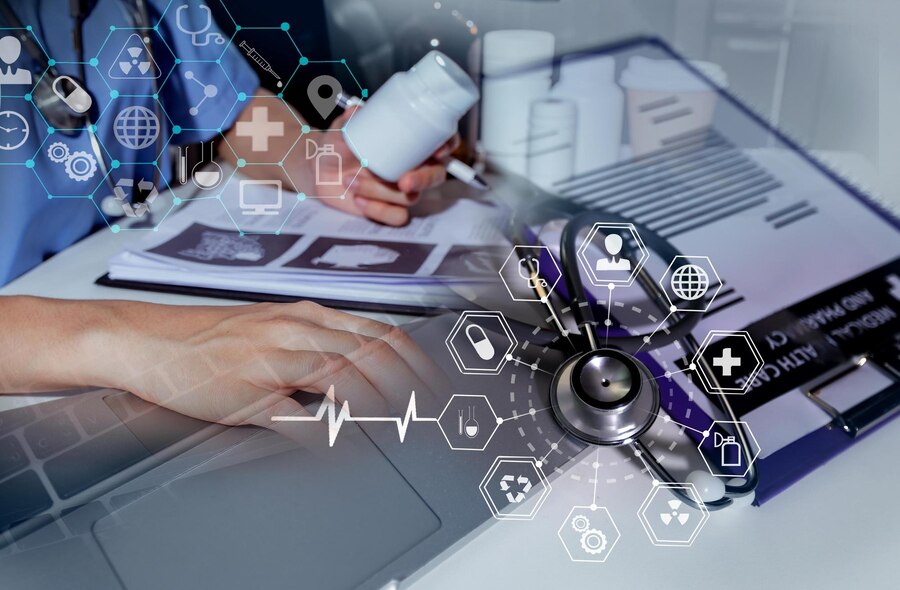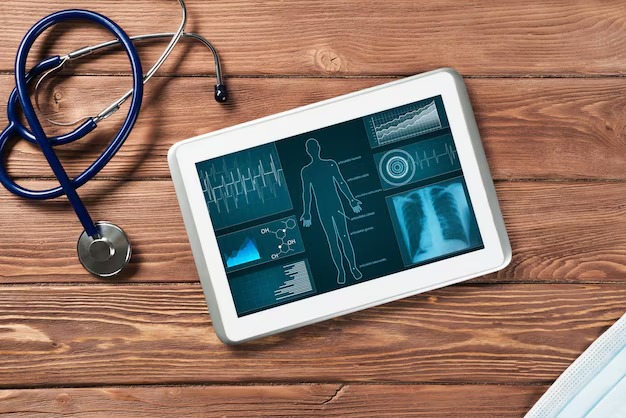Cloudpital # 1 is one of the top EMR has changed considerably over the last several decades, and technology has been at the forefront of revolutionizing how patient care is delivered. Perhaps one of the most striking developments has been the widespread expansion of telemedicine—healthcare services that are delivered remotely through the use of technology such as video conferencing, telephone calls, and computer-based messaging. Since telemedicine demand is rising further, particularly amid the COVID-19 pandemic, healthcare professionals want to incorporate telemedicine into their practice while making sure patient care is efficient, secure, and of high quality.
Click to Start Whatsapp Chatbot with Sales
Mobile: +966547315697
Email: sales@bilytica.com
Cloudpital # 1 EMR

Centralized Patient Information
One of the essential functionalities of EMR software is centralization of patient data in electronic form. This centralized database contains patient demographics, clinical history, allergies, medications, laboratory results, imaging, diagnoses, and treatment plans. It is easily retrievable and can be released to authorized clinicians, making all necessary patient information available at the point of care.
When delivering telemedicine services, healthcare professionals must be able to tap into this full patient record in real-time to inform their decisions. Whether a doctor is having a video consultation or responding to a patient’s health query using an encrypted messaging system, access to a patient’s medical history is essential. Without this essential information, remote consultations might result in partial diagnoses or treatment mistakes.
Real-Time Updates and Documentation
In telemedicine consultations, it is imperative that healthcare providers make real-time documentation of patient encounters in the same way that they do during face-to-face visits. EMR software makes this possible through the capture of providers’ notes, diagnoses, and treatment plans in real-time while they are attending the telemedicine session. Real-time capture of such information guarantees that the patient’s medical record is current, which is important for continuity of care and proper tracking of medical history.
In addition, real-time documentation guarantees that every patient interaction, including online consultations, is securely stored and is in accordance with applicable healthcare legislation, like the Health Insurance Portability and Accountability Act (HIPAA) in the United States. This eliminates any lapses in the patient record and ensures that follow-up treatment, referrals, or medication is properly documented and available for future reference.
Telemedicine Integration for Seamless Communication
EMR systems will regularly have features integrated with telemedicine platforms that enable healthcare workers to communicate with patients through video calls, voice consults, or secure messaging systems. The integrated systems make sure all areas of a patient’s care—whether it’s face-to-face or virtual—are linked and documented through the same platform.
This smooth integration of telemedicine with EMR software allows healthcare professionals to seamlessly switch between remote and in-clinic care when necessary. For example, if a patient needs to have an in-clinic follow-up appointment following a telemedicine session, the practitioner can book the appointment within the EMR system, which ensures that all relevant information is communicated and readily available.
Workflow Efficiency
Telemedicine tends to make healthcare professionals perform several tasks at once—talking to patients, reading medical histories, recording encounters, and handling administrative tasks. Without an organized system, these activities can be too much to handle, resulting in inefficiencies, mistakes, and delays.
EMR technology facilitates telemedicine through streamlined workflows and automating most of these activities. For instance, EMRs can automatically create medical codes for billing purposes, monitor appointments, and send reminders for follow-up treatment. Automations reduce administrative overhead, enabling the healthcare providers to concentrate more on patient care than on administrative tasks.
Patient Access to Health Information
One of the main benefits of EMR software is that it can offer patients access to their own medical records via secure patient portals. Most EMR systems have patient portal capabilities that enable patients to see test results, request refills on prescriptions, schedule appointments, and message their healthcare providers online.
This functionality is especially handy for telemedicine. Patients have access to their medical information prior to, during, and subsequent to remote visits. They are able to read over their care plans, submit additional questions using secure messaging, and monitor their course of treatment, all on the comfort of their devices. EMR software, by making the patient more engaged in accessing his or her records, enhances patients’ understanding and participation in managing their care.

Ensuring Compliance and Security
Telemedicine creates special challenges around patient data protection and compliance. When care is provided remotely, it’s important to make sure that patient information is securely transmitted and stored in order to protect privacy and comply with regulations such as HIPAA in the U.S. EMR software is instrumental in helping to meet these needs.
HIMS Software employ encryption protocols to ensure the secure transmission of patient information during telemedicine sessions so that unauthorized parties cannot access them. Secure login procedures, multi-factor authentication, and audit trails further facilitate that only permitted healthcare providers will have access to sensitive patient information.
Remote Monitoring and Chronic Care Management
Telemedicine is particularly useful for chronically ill patients who need frequent monitoring and care. EMR software facilitates remote monitoring through interfacing with medical devices like blood pressure meters, glucose meters, or pulse oximeters. Such devices can upload patient information to the EMR system directly, where the health care professionals can view the information in real time and make adjustments to the treatment plan accordingly.
For patients managing chronic diseases, EMR software enables healthcare providers to track trends in their condition, adjust medications, and provide timely interventions, all without requiring the patient to visit the clinic. This remote monitoring capability allows healthcare providers to deliver continuous care, reducing the need for frequent in-person visits and helping patients manage their conditions more effectively.
Enhanced Coordination of Care
Telemedicine is usually combined with other healthcare services such as specialist referrals, home health visits, or follow-up. EMR software facilitates the coordination of care through the ease with which patient information can be shared between various systems and among specialists.
With Mobile EHR a doctor can safely transfer patient data to specialists, arrange virtual consultations, and monitor the treatment progress of a patient through various healthcare environments. This connection of telemedicine with other treatment channels ensures that patients are fully treated and that no vital information slips through the cracks.
Conclusion
The combination of EMR software and telemedicine provides healthcare professionals with an effective solution for providing remote care while preserving the efficiency, accuracy, and security of traditional in-person care. EMR systems enhance telemedicine through centralization of patient information, real-time documentation, enhanced communication, regulatory compliance, and remote monitoring. Moreover, the interoperability of telemedicine platforms with EMR software enhances workflow effectiveness, patient engagement, and care coordination.
As telemedicine becomes increasingly popular and significant, the role of EMR software in facilitating these services will become increasingly vital. By providing a secure, effective, and complete platform for patient data management, EMR systems guarantee that healthcare professionals can provide high-quality care no matter where they are, ultimately enhancing patient outcomes and satisfaction.
How does EMR Software support telemedicine? similar software solutions prices were updated on 2025-12-08T07:16:00+00:00 in Saudi Arabia in Mecca, Medina, Riyadh, Khamis Mushait, Yanbu, Jeddah, Dammam, Unaizah, Uqair, Ha’il, Ta if, Al Bahah, Dhahran, King Abdullah Economic City, Najran, Diriyah, Qatif, Khafji, Jubail, Abqaiq, List of Cities and Towns in Saudi Arabia, Ras Tanura, Turubah, Jazan Economic City, Knowledge Economic City, Medina, Khobar, Abha, Tabuk, Saudi Arabia, similar software solutions prices were updated on 2025-12-08T07:16:00+00:00 We also provide in Saudi Arabia services solutions company in Hafar Al-Batin, Udhailiyah, Al-Awamiyah, Hofuf, Hautat Sudair, Buraidah, Tayma, Duba, ‘uyayna, Saihat, Al-Kharj, Al-ula, Jizan, Rumailah, Ar Rass, Arar, Shaybah, Al Majma’ah, Rabigh, Dhurma, Haradh, List of Saudi Cities by Gdp Per Capita, Badr, Sudair Industrial City, Baljurashi, Shaqraa, Al-Khutt, Habala, Ad Dawadimi, Dawadmi, Layla, similar software solutions prices were updated on 2025-12-08T07:16:00+00:00 Price is SAR 100 and this was updated on updated on 2025-12-08T07:16:00+00:00 similar How does EMR Software support telemedicine? software solutions prices were updated on 2025-12-08T07:16:00+00:00 in Saudi Arabia in Haql, Afif, Al-Abwa, Farasan, Al-Jaroudiya, Thadig, Al-Thuqbah, Al Wajh, Almardmah, Al-Zilfi, Muzahmiyya, Prince Abdul Aziz Bin Mousaed Economic City, Tharmada’a, Skaka, Um Al-Sahek, Sharurah, Tanomah, Bisha, Dahaban, Al Qunfudhah, Qurayyat, Saudi Arabia, Ha’ir, as Sulayyil, Al Lith, Turaif, Al-Gway’iyyah, Samtah, Wadi Ad-Dawasir, Az Zaimah, Safwa City, Jalajil, Harmah, Mastoorah, Hotat Bani Tamim, Jabal Umm Al Ru’us, Rafha, Qaisumah, Al-Ghat, Hajrah, Al-Hareeq. Excerpt: Jeddah (also spelled Jiddah, Jidda, or Jedda; Arabic: Jidda) is a Saudi Arabian city located on the coast of the Red Sea and is the major urban center of western Saudi Arabia similar software solutions prices were updated on 2025-12-08T07:16:00+00:00 Price is SAR 100 and this was updated on updated on 2025-12-08T07:16:00+00:00

